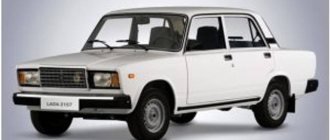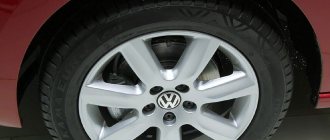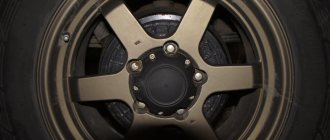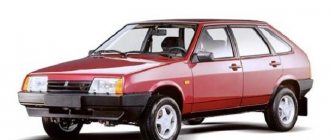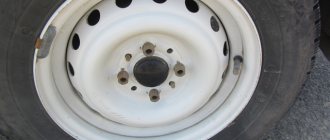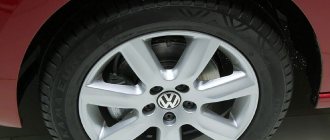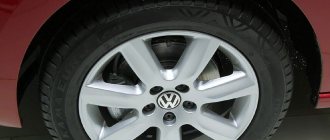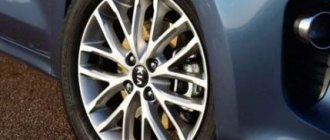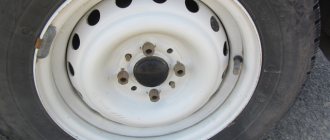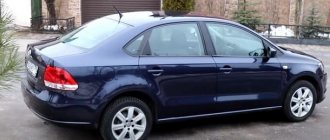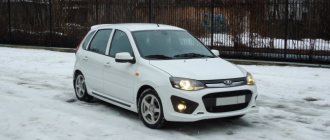The bolt pattern of Volkswagen Polo wheels is a very important parameter that the car owner needs to know when selecting a new set of rims for this car. In some sources, another name for this parameter is often found - drilling. This data is very important to know how the wheel is attached to the suspension components.
Volkswagen Polo Sedan is a very practical, economical and popular vehicle on the roads of Russia and beyond. The high popularity is associated with the brand’s pleasant pricing policy for this model and the excellent level of quality. The Volkswagen concern is constantly improving its models, introducing the latest developments and achievements obtained on other brands.
Wheel bolt pattern "Volkswagen Polo"
Wheels for different versions of Volkswagen Polo
Various modifications of the Volkswagen Polo have their own sizes and characteristics. This applies not only to the specific model, but even to the year of manufacture. Manufacturers are trying to create the most favorable conditions for movement.
So, a liter Polo requires the installation of 13*4.0 wheels until 1994, after which 13*5.0 were installed. This made it possible to slightly reduce the disc offset from 38 to 35. This decision and the use of a certain tire size also had an impact. The rims on cars with a 1.2 engine remained virtually unchanged: 14*5.0 (6.0) or 15*6.0.
The FSI model with a 1.4-liter engine produced in 2007 requires the mandatory installation of 14*5.0 or 14*6.0 wheels. This also affects its offset and allows the use of completely different tires.
This suggests that not every Volkswagen Polo model can use the same wheel parameters. This issue should be approached with all responsibility, so as not to worry while driving on the roads.
When installing discs (casting) on the Trend version, you should use 5J*14 discs, which have an offset of 35. The Comfort version provides 6J*15, which has an offset corresponding to 38 mm.
Disc size indicators
There are five main sizes, an error in determining which will result in the impossibility of installing the wheel.
These include:
- number of bolt holes (LZ);
- the distance between them;
- diameter of the circle on which they are located (PCD);
- diameter of the central (hub) window (DIA);
- departure (ET).
The number of windows for bolts on passenger cars varies from 3 to 6. For trucks, this figure reaches 12-15 pieces. Togliatti-made cars have 4 bolt entries. The exception is the Lada Niva, the wheels of which are secured with five bolts each. The number of holes is measured visually by simple counting.
Standard wheels
In the standard version, the Volkswagen Polo sedan is equipped with “stampings” 5J-14, as well as 6J-15. In this case, 5 and 6 are the rim width, which is measured in inches on alloy wheels, J is the rim flange profile shape, and 14 and 15 are the rim diameter.
If you take a Polo in a Highline sedan body, it is marked with wheels 6J*15 ET 40 PCD 5*100. The correct location of the bolts is very important here, the distance between which must be maintained strictly at 100 mm. Disc offset (ET) is the distance to the plane of symmetry of the rim from its direct mounting. The unit of measurement used is millimeter. This is all provided for light alloy wheels.
The Volkswagen Polo is produced from the factory with an offset of 35 to 40 mm. In this case, the bolts are always located at a distance of 100 mm and are screwed in in the amount of 5 pieces.
The standard wheels will differ from each other in terms of bodywork. The parameters will be as follows:
- GF-6NAHW. All versions of the car produced in 2000 are equipped with wheels measuring 14*6.0 or 15*6.0. For this reason, the offset of the disk 43 and 45, respectively, will differ, which indicates the impossibility of using identical disks on different vehicles.
- ABA-9NBUD. If you take a car made in 1996, the wheels are 13*5.5 with an offset of 43. In 2007, 14*6.0 with a similar offset were installed on the car.
- GH-9NBBY. Wheel samples changed almost every year, as not only the size was adjusted from 14 to 16, but also the rim width from 6.0 to 6.5. But the offset and drilling remained unchanged.
- GH-9NBKY. In 2004-2007, the disks did not change and remained the same, namely 14 * 6.0. The only thing that is different is for the 2006 model. a rim diameter of 15 could be used, with all other identical parameters.
They use 5*100 drill bits almost everywhere. The only exception is the 2000 model GF-6NAHW body, which uses 4*100.
Engineers at the German car manufacturer do not rule out installing wheels with a diameter of R16 instead of standard ones. This is more focused on tuning and more on classic performance. But if the vehicle is purchased from a showroom, you can immediately forget about warranty service related to the chassis. That is, only the owner should decide this. This is called an experiment attempt, for which no one bears responsibility.
This is interesting: What kind of wheel bolt pattern is there in the field?
see also
Comments 149
Tell me, will r17 and ET 52 fit? On the polo sedan
Dear Vladimir, read my comment more carefully, there is not a single word about the RUDDER. We are talking about the STEERING AXLE. Your quote from the text is that when ET changes, “in both cases the steering axis shifts,” so I wonder what kind of steering axis it is and where it shifts. Please clarify. Even more strange is your statement that a car does not have a steering wheel, and only ships and airplanes have one; it is strange how you drive your car without a steering wheel. Let’s not look into the etymology of the word “RUL”, let’s look at the dictionary, where the word RUL means a device for controlling the movement of a ship, airplane, car, tractor, etc. in a given direction (synonyms: steering wheel, steering wheel, steering wheel, etc.). By the way, the term helm, which has taken root on watercraft and aircraft, also means steering wheel, from the Dutch “stuur” - steering wheel and “wiel” - wheel. For reference, the first steering wheels on a car were lever-shaped in the form of a tiller, and then one craftsman installed a boat steering wheel on the car. Since then, the steering wheel has acquired the familiar shape of a wheel, and since we steer with this wheel, it is called a steering wheel. Regarding the wheel and disk, I understand that 99 out of 100 will say that it is a disk, but one will correctly say the wheel, and then another, etc. And you see, we will get rid of the slang imposed by illiterate traders who rushed to sell spare parts during the era of the collapse of the Union, and then disks (wheels), eggs (stabilizer strut), pig (industrial bearing support), TV (radiator frame), catalysts (catalytic converters) will probably disappear ) etc. By the way, you yourself accidentally started this fight when you wrote that 15 is the bore diameter, not RADIUS, but for many R15 means RADIUS. Quite recently, even sales consultants in car dealerships and auto shops plainly claimed that the R15 is a 15-radius wheel. I think that the correct terminology should be used not only in factories and technical departments. Vladimir You didn’t happen to study in the Murmansk region, my classmate is also Egorov Vladimir.
Dear author, you need to start by using the correct terminology accepted in the automotive industry. What you call a DISK is a WHEEL. In the automotive industry, a wheel is a structural element of a car located between the hub and the tire. Try typing GOSTS on the wheels and GOSTS on the wheels will pop up for you. I’m tired of repeating that wheels can be disc, discless, flanged, spoked, collapsible and non-dismountable, etc. If you call a discless wheel (used on heavy-duty vehicles) a disc, you will get a DISCLESS DISC or oiled wheel. The disc type of wheel, which is best known to the general consumer, consists of a DISC and a RIM. The disk is the part of the wheel with which the wheel is attached to the car hub, and the tire is mounted on the wheel rim. In the wheel markings, such parameters as PCD (bolt pattern according to you) and DIA (diameter of the central hole of the wheel disk) refer to the wheel disk, and 5j (width and shape of the side flange of the rim) and 15 (fitting diameter of the wheel rim in inches) refer to the rim wheels. ET offset, the distance between the plane of attachment of the wheel disk to the car hub and the central plane of rotation of the wheel rim, as can be seen in the ET wheel, the parameters of both the disk and the wheel rim are combined. I completely agree that ET is the most important parameter when choosing wheels and I don’t recommend playing with it when choosing a wheel. An example is the history of the domestic automobile industry: they produced classic VAZs on wheels with ET 29, and then front-wheel drive ones with wheels with ET40 appeared; all other parameters were suitable. Few people have heard about the offset and the owners began to install classic wheels on front-wheel drive, while the track increased by 22mm. This was enough to shift the load to the outer part of the bearing (by 11mm) of the wheel hub and a wave of complaints began. Having figured out the reason, the plant drew the attention of consumers that the wheels for these cars are not interchangeable. And this is not the most serious consequence of choosing the wrong wheel according to ET. But it’s difficult for me to understand how offset affects the displacement of the steering axle and, in general, what the author understands by this concept. And I also think that the size of 57.1 mm is the size of the central hole of the DIA wheel, but what the author means by hub diameter and which hub is not clear to me . I completely agree with the author’s main idea - when choosing wheels and tires, you must strictly follow the manufacturer’s recommendations and this will save you from many economic and legal troubles.
Mounting bolts
The fit of the bolts used on standard discs is spherical. They should be of the following type:
- Bolt cap for fixing the wheel – 3СО 601 173.
- Wheel security bolts included M14X1.5x27.5, 1KO 698 137A.
- WHT 001 812 is available for a single bolt of this size.
The correct bolt pattern guarantees a high-quality and long-lasting ride without consequences. You should be careful here, especially when installing non-standard wheels.
Overhang amount
Reach is no less important. Identified as DEPORT or OFFSET and expressed in mm.
There are three types of disc offset:
- Positive - the disk seems to be recessed into the middle of the wheel arch.
- Negative - most of the disk comes out, while the seat is “recessed” deep inside the disk itself.
- Zero – when both planes (imaginary and mating) coincide.
If a disk is purchased without matching the offset, it simply will not be possible to install it, since the suspension elements will not allow this.
Disc selection
There is a huge range of wheels on the market that can be easily installed on a Volkswagen Polo car. They can be made of steel or casting. The dimensions are also different, which will fully depend on the car model, year of manufacture and other parameters.
Much will depend on the manufacturers, who have a slightly different approach to the process of creating wheels for cars, which affects the quality and duration of the operating period. Among them, the most popular manufacturers are:
- K&K. Most often, original discs of high quality are offered. Presented in a classic silver color, size p15*J6 ET 40. Russian production is also pleasant in price. The cost of one disc is approximately 3,500 - 4,000 rubles.
- Alutec.
- Le Mans.
- Milan.
- Sakura.
This all applies to the creators of alloy wheels, which bring great attractiveness to vehicles. But as mentioned earlier, you should not experiment, especially if you own a car from a dealership that is covered by warranty. The manufacturer Wolf has the best quality. But here it offers consumers even a diameter of R17 with J7.5. The price will vary between 5,000 – 6,000 rubles, depending on the place of purchase.
Cheaper options on the market are brands for the Volkswagen Polo sedan such as Akula, M33, CR-06, Kyoto, the cost of which starts from 2,500 - 3,000 rubles.
There is a purchase option for installing conventional “stampings”, the cost of which ranges from 1,000 – 1,500 rubles. Article numbers AR075, 7280T, X40028 and other options are usually used. Much depends on the diameter of the stamped disc and its other parameters, which are shown in the photo.
1.9TDi 148hp
| Volkswagen Golf 2005 | 1.9TDi |
| Generation: | Mk4 [1997..2005] |
| Power: | 148 hp | 110 kW | 150 PS |
| Engine: | l4, Diesel |
| DIA: | 57.1mm |
| Thread: | M14 x 1.5 |
| Fastening type: | Bolt |
| Years of production: | [2000 .. 2005] |
| Tire | Disk | Tire pressure | Sverlovka |
| 195/65R15 91V | 6Jx15 ET38 | 2.1 / 1.9 30 / 28 | 5×112 |
| 205/60R15 91V | 6.5Jx15 ET35 | 2.1 / 1.9 30 / 28 | 5×112 |
| 205/55R16 91T | 5.5Jx16 ET36 | 2.1 / 1.9 30 / 28 | 5×112 |
| 205/55R16 91V | 6.5Jx16ET42 | 2.1 / 1.9 30 / 28 | 5×112 |
| 225/50R16 87H | 7.5Jx16 ET36 | 2.3 33 | 5×112 |
| 225/45ZR17 94W | 7Jx17 ET38 | 2.1 / 1.9 30 / 28 | 5×112 |
Polo wheel bolt pattern
The year of production of this legendary model can be called 1975. It is still in production and has gone through many generations. The car is constantly among the top ten most popular and best-selling vehicles in the world. The model has earned very high distribution and critical reviews. Thanks to the excellent quality, which is strictly observed and controlled in the brand's factories, Polo has gained many fans around the world
Wheel rims installed on a car most affect its behavior on the road surface, handling, dynamic qualities and other characteristics. Knowing the drilling parameters and wheel sizes for the Polo, you can select and purchase tires for it from a very large assortment. Wheels of high-quality and well-known brands will help to perfectly update the appearance of the car and make it stand out from the crowd. Most often, car owners change wheels due to the change of season, but this also happens due to increased wear or a desire to improve the appearance with tuning.
Note!
Choosing original factory wheels will allow the car to fully demonstrate all its characteristics.
If the original appearance of the car becomes boring, then in this case tuning comes to the rescue, which allows you to improve the car technically and visually. It is possible to replace certain components with improved, sportier and more attractive ones. The main element on which the appearance of a vehicle depends is the wheels.
You may be interested in what is PCD on rims
In this regard, car owners most often change them first. However, for any car, wheels are not only part of the design, but also an important technical component. Road stability, handling and dynamic qualities depend on the characteristics and properties of tires and wheels, weight and many other properties.
New wheels must comply with the original factory parameters and characteristics.
When selecting a set of products, the bolt pattern for Polo must be taken into account as the most important part. It is also necessary to choose the right tires, since incorrect sizes will have a bad effect on operation.
The drilling parameter determines whether it is possible to install the selected rims on the car. If these parameters do not correspond, then special adapter rings should be used, which entails mandatory intervention in the factory design.
Note!
Unlike the younger model, the wheel bolt pattern of the Volkswagen Jetta has slightly different parameters and is similar to the Passat.
Volkswagen Polo rims: bolt pattern
Generation 5 and 6
In the fall of 2003, the Volkswagen Golf V premiered in Frankfurt. The car was based on the latest platform, previously used for the Volkswagen Touran and Audi A3 II. The model also received a body with increased rigidity by 80% and a multi-link rear suspension. The dimensions of the car have become even larger. The rear passengers especially felt the increase, their legroom increased by 65 mm.
The design of the model consisted of 5 main elements, a clear silhouette of the side windows forming a single whole; belt line under the side windows; embossed sidewalls, a sweeping roofline and a specific C-pillar shape. Round twin headlights, pointed towards the center, appeared in front. Together with the radiator grille, they formed a V-shape.
The interior of the Volkswagen Golf V was made functional and extremely strict. All levels were clearly separated, and buttons and indicators were installed in their places. German designers improved most of the elements. The front seats have been completely updated.
Wheel sizes
The fifth generation again received a rich range of engines:
1. 1.4-liter gasoline engine (75 hp):
- 6J wheels on 15 ET47, tires – 195/65R15;
- 6J wheels on 16 ET47, tires – 195/60R16;
- 6.5J wheels on 17 ET50, tires – 195/55R17.
2. 1.6-liter gasoline engine (102 or 115 hp):
- 6J wheels on 15 ET47, tires – 195/65R15;
- 6.5J wheels on 16 ET47, tires – 205/60R15;
- 6.5J wheels on 16 ET50, tires – 205/55R16.
3. 1.8-liter turbo engine (180 hp):
- 7J wheels on 17 ET54, tires – 225/45R17;
- 7.5J wheels on 18 ET51, tires – 225/40R18;
- wheels 8J by 19, tires – 225/35R19.
4. 2-liter FSI (150 and 200 hp):
- 6.5J wheels for 16 ET50, tires – 205/55R16;
- 6.5J wheels on 17 ET50, tires – 205/50R17;
- wheels 7J on 18 ET47, tires – 205/45R18.
5. 1.9-liter and 2-liter turbodiesels (105 and 140 hp):
- 6J wheels on 15 ET47, tires – 195/65R15;
- 6.5J wheels for 16 ET50, tires – 205/55R16;
- 7J wheels on 16 ET47, tires – 225/50R16.
6. Version R32 with a 250-horsepower unit:
- 7.5J wheels on 18 ET51, tires – 225/40R18;
- 8.5J wheels on 19 ET45, tires – 255/30R19;
- wheels 9J on 20 ET42, tires – 265/25R20.
For this generation, the drilling parameters have changed:
- PCD (drilling) – 5 by 112.
Generation 6
The sixth generation of the Volkswagen Golf was presented in the summer of 2009. The appearance of the model has become as sporty as possible. At the front of the body, the elegant shape of the headlights, in line with the company's new philosophy, and the stylish radiator grille stood out. Due to the clearly defined line from the headlights to the rear lights, the body was visually stretched, making the car lower.
The interior of the Volkswagen Golf VI has a lot of decorative inserts and chrome applications. The new dashboard design features white backlighting. Already in the “base” the car was equipped with a climate control system “Climatic”.
The range of power units of the model has remained virtually unchanged. The sixth generation is based on a 1.6-liter unit (102 hp). The characteristics of the wheels (see 5th generation), characteristic of each modification, have also remained the same. At the same time, a new transmission appeared - a 7-speed DSG gearbox.
What is the wheel bolt pattern on a Volkswagen Polo sedan?
The Volkswagen Polo sedan version is equipped with rims with the following dimensions and parameters:
- R14/5.0J PCD 5×100 ET 35 DIA 57.1 - “Trendline” version;
- R15/6.0J PCD 5×100 ET 38 DIA 57.1 - maximum Highline configuration.
You might be interested in this About rims for Mazda 6
The drill size of the model is 5×100, the reach dimensions are from 35 to 38 millimeters, the diameter of the centering hole is 57.1 millimeters. When selecting products for a car, you must be guided only by these parameters; others simply will not work.
It is also important to take into account the width of the wheel rim, which in this case varies from 5.0 to 6.0. When choosing this larger size, you must take into account that the wheels may simply not fit in the arch. In addition, the offset parameter, designated ET, also varies, since it depends on the width of the rim. If this size is selected poorly, handling will be negatively affected and increased load will be placed on the suspension components.
Important!
All listed parameters and dimensions must be strictly observed. If some can be changed within certain limits, then it is undesirable to go beyond these limits.
Among the main features of the bolt pattern for the Polo model, one can highlight the prevalence of this parameter among European manufacturers. Related models from Skoda also received identical wheels. In this regard, there should be no problems with the selection of disks.
The bolt pattern of the latest generation Polo wheels is absolutely identical to the previous ones. To secure the wheels, five bolts are used, the mounting holes for which are located in a circle with a diameter of 100 millimeters. This means that wheels from an older modification can be installed on a new one, and vice versa. This makes life easier for car owners. For example, the wheel bolt pattern for Golf 4 is identical to Polo.
Fourth generation Golf
Parameters for various other brand models
The Touareg wheel bolt pattern and other required rim dimensions are equal to the following data:
- The number of mounting holes and the diameter of their location circle is 5x130;
- The diameter of the car hub is 71.5 millimeters;
- Rim diameter - from 17 to 20 inches;
- Rim offset - from 55 to 60 millimeters;
- Recommended width is 7.5 to 9.0 inches.
The bolt pattern for the Tiguan and the recommended wheel sizes for it are as follows:
- The rim drilling is 5×112;
- Rim width - from 6.5 to 9.0 inches;
- Rim diameter - from 16 to 19 inches;
- Wheel offset - ET from 33 to 38 millimeters;
- The diameter of the central hole is 57.1 millimeters.
It is important to know
Installing the wrong disks will cause a decrease in traffic safety due to the fact that vehicle control will deteriorate and the dynamic properties of the vehicle will decrease.
Attention! You should select the wheel size according to the factory requirements, which are specified in the vehicle’s operating manual.
Buy elements ranging from 5J to 7J with a radius of R14 - R. Some motorists manage to install wheels with a larger diameter, but this will lead to rapid wear and failure.
When choosing tires, you can use this table:
| Tire size | 235/35R-19 91W M+S | 225/40R-18 92 W M+S | 225/45R-17 91V M+S | 205/55R-16 91V M+S | 195/65R-15 91V M+S |
| Profile width, cm | 23.5 | 22.5 | 22.5 | 20.5 | 19.5 |
| Profile height, cm | 8.2 | 9 | 10.1 | 11.3 | 12.7 |
| Tire outer diameter, cm | 64.7 | 63.7 | 63.4 | 63.2 | 63.5 |
| Tire inner diameter, cm | 48.3 | 45.7 | 43.2 | 40.6 | 38.1 |
For your own safety on the road, ideal control of the car and preservation of its dynamic properties, you should choose new wheels taking into account the drilling of the bolt pattern of Volkswagen Polo wheels.
What is disc bolt pattern and how to determine it, you will learn from this video:
This video will tell a car enthusiast how to read the wheel rim markings:
It is important to know
Installing the wrong disks will cause a decrease in traffic safety due to the fact that vehicle control will deteriorate and the dynamic properties of the vehicle will decrease.
Attention! You should select the wheel size according to the factory requirements, which are specified in the vehicle’s operating manual.
Buy elements ranging from 5J to 7J with a radius of R14 - R. Some motorists manage to install wheels with a larger diameter, but this will lead to rapid wear and failure.
When choosing tires, you can use this table:
| Tire size | 235/35R-19 91W M+S | 225/40R-18 92 W M+S | 225/45R-17 91V M+S | 205/55R-16 91V M+S | 195/65R-15 91V M+S |
| Profile width, cm | 23.5 | 22.5 | 22.5 | 20.5 | 19.5 |
| Profile height, cm | 8.2 | 9 | 10.1 | 11.3 | 12.7 |
| Tire outer diameter, cm | 64.7 | 63.7 | 63.4 | 63.2 | 63.5 |
| Tire inner diameter, cm | 48.3 | 45.7 | 43.2 | 40.6 | 38.1 |
For your own safety on the road, ideal control of the car and preservation of its dynamic properties, you should choose new wheels taking into account the drilling of the bolt pattern of Volkswagen Polo wheels.
What is disc bolt pattern and how to determine it, you will learn from this video:
This video will tell a car enthusiast how to read the wheel rim markings:
Tire classification
Depending on operating conditions, the following classes of tires are distinguished.
- 1. Summer tires are designed for use in the summer, mainly on highways. The tread pattern consists of blocks or ribs separated by grooves (usually not wide).
- 2. All-season tires type M+S (Mud + Snow “mud” and “snow”) and R+W (Road + Winter “road” and “winter”) are designed for use in both winter and summer. Provide acceptable performance characteristics for year-round use on highways and dirt roads. The pattern is more sparse than that of summer tires and may have microgrooves (lamellas) that provide traction on icy and snowy roads.
- 3. Winter tires are used for use on winter roads:
- non-studded are made of soft types of rubber, most often with a directional pattern with a large number of lamellas and are intended mainly for use on cleared roads;
- studded or with the possibility of studding, made of medium-hard rubber, with spikes or marked places for mounting spikes. The tread pattern is sparse, with a developed network of lamellas. They provide good cross-country ability in deep snow and remove slush well. Studded tires have better grip on ice and compacted snow compared to non-studded winter tires. However, studs impair grip on hard road surfaces and create increased noise.
Depending on the arrangement of the elements, tread pattern can be non-directional, directional or asymmetrical:
- non-directional pattern symmetrical relative to the radial plane of the wheel (passing through its axis of rotation). It is the most universal, so most tires are produced with this pattern;
- the directional pattern is symmetrical relative to the central plane of rotation of the wheel (passing through the middle of the tread). It has an improved ability to drain water from the contact patch with the road and reduced noise. The spare wheel coincides in the direction of rotation only with the wheels of one side of the car, but temporarily installing it on the other side is permissible when driving at low speeds;
- asymmetrical pattern is asymmetrical relative to the central plane of rotation of the wheel. It is used to implement different properties in one bus. For example, the outer side of a tire works better on dry roads, and the inner side on wet roads.
Tires are also distinguished by the method of sealing the cavity. Tires come with or without a tube. Tubeless tires are generally considered more reliable than tubed tires because when the tire is punctured, air only leaves the tire through the puncture hole, while in tubed tires, air flows out of the tire cavity around the entire circumference of the mounting hole because the seal of this connection is broken. . Therefore, a tubeless tire allows more time to maneuver before driving on a damaged wheel becomes dangerous. In addition, tubeless tires are lighter than their tubed counterparts. On the side of a tubeless tire you can find the designation “TUBELESS”, “TL”, on the side of a tubeless tire “TUBETYPE”, “TUBED TIRE”.
Based on the arrangement of threads in the carcass and belt, tires can be diagonal or radial.
- Bias tires, the carcass of which consists of one or more pairs of cord layers arranged so that the threads of adjacent layers intersect. Bias tires have already been almost completely replaced from the market by radial tires. The design of bias-ply tires is outdated, but they continue to be produced in small quantities because they are relatively cheap to produce. The only advantage of these tires is that they have a stronger sidewall.
- radial tires in which the carcass cord is stretched from one bead to the other without overlapping threads. The direction of thread tension follows from the name.
The thin soft shell of the frame is covered on the outer surface with a powerful flexible belt made of high-strength inextensible cord, usually steel. Therefore, “BELTED” or “STEEL BELTED” is often added to the inscription “RADIAL” on the sidewalls of tires.
This arrangement of cord layers reduces the tension in the threads, which makes it possible to reduce the number of layers, gives the frame elasticity, and reduces heat generation and rolling resistance.
Radial tires have many advantages: they are more comfortable, durable, stable, and have lower rolling resistance. Diagonal tires are preferable to use off-road and with high impact loads on the wheel.
